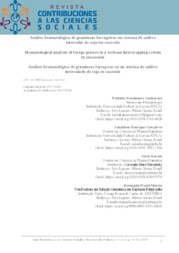Análise bromatológica de gramíneas forrageiras em sistema de cultivo intercalar de soja em sucessão.
Análise bromatológica de gramíneas forrageiras em sistema de cultivo intercalar de soja em sucessão.
Author(s): GUIMARÃES, N. N.; GONÇALVES, A. H.; KARAM, D.; SIMEÃO, R. M.; BORGHI, E.; SILVEIRA, M. C. T. da; GUIMARÃES, L. N.; LARA, J. de P.
Summary: RESUMO- O objetivo deste experimento foi avaliar o valor nutritivo de plantas de cobertura do cultivo intercalar de soja em sucessão. Os tratamentos foram dispostos em faixas e, em todos eles, a soja foi semeada no verão e as plantas de cobertura na segunda safra, conforme descrição: Faixa 1 – Forrageiras RUS (Raphanus sativus + Urochloa brizantha cv. BRS Piatã + Stylosanthes spp. cv. Campo-grande) semeadas na entrelinha da soja, antes da colheita da oleaginosa (Antecipe); Faixa 2 – Forrageiras UCU (Urochloa ruziziensis + Cajanus cajan cv. Bonamigo + Stylosanthes spp. cv. Campo-grande) Antecipe; Faixa 3 – Forrageiras CMMS (Crotalaria breviflora + Megathyrsus maximus cv. BRS Tamani + Stylosanthes spp. cv. Campo-grande + Stylosanthes guianensis cv. Bela) Antecipe. Nas variáveis massa seca, cinzas, proteína bruta, celulose e sílica, Megathyrsus maximus cv. BRS Tamani (CMMS, 93,36, 9,84, 12,44, 29,76, 2,80%) apresentou maior percentual. As gramíneas forrageiras analisadas são adequadas para alimentação dos ruminantes. ABSTRACT- The objective of this experiment was to evaluate the nutritional value of cover crops for intercropping soybeans in succession. The treatments were arranged in strips and, in all of them, soybeans were sown in the summer and cover crops in the second harvest, as described: Band 1 – Forrageiras RUS (Raphanus sativus + Urochloa brizantha cv. BRS Piatã + Stylosanthes spp. cv. Campo-grande) sown between the soybean rows, before the oilseed harvest (Antecipe); Band 2 – Forage UCU (Urochloa ruziziensis + Cajanus cajan cv. Bonamigo + Stylosanthes spp. cv. Campo-grande) Anticipate; Band 3 – CMMS Forages (Crotalaria breviflora + Megathyrsus maximus cv. BRS Tamani + Stylosanthes spp. cv. Campo-grande + Stylosanthes guianensis cv. Bela) Anticipate. In the variables dry mass, ash, crude protein, cellulose and silica, Megathyrsus maximus cv. BRS Tamani (CMMS, 93.36, 9.84, 12.44, 29.76, 2.80%) presented the highest percentage. The forage grasses analyzed are suitable for feeding ruminants.
Publication year: 2024
Types of publication: Journal article
Unit: Embrapa Maize & Sorghum
Observation
Some of Embrapa's publications are published as ePub files. To read them, use or download one of the following free software options to your computer or mobile device. Android: Google Play Books; IOS: iBooks; Windows and Linux: Calibre.
Access other publications
Access the Agricultural Research Database (BDPA) to consult Embrapa's full library collection and records.
Visit Embrapa Bookstore to purchase books and other publications sold by Embrapa.

